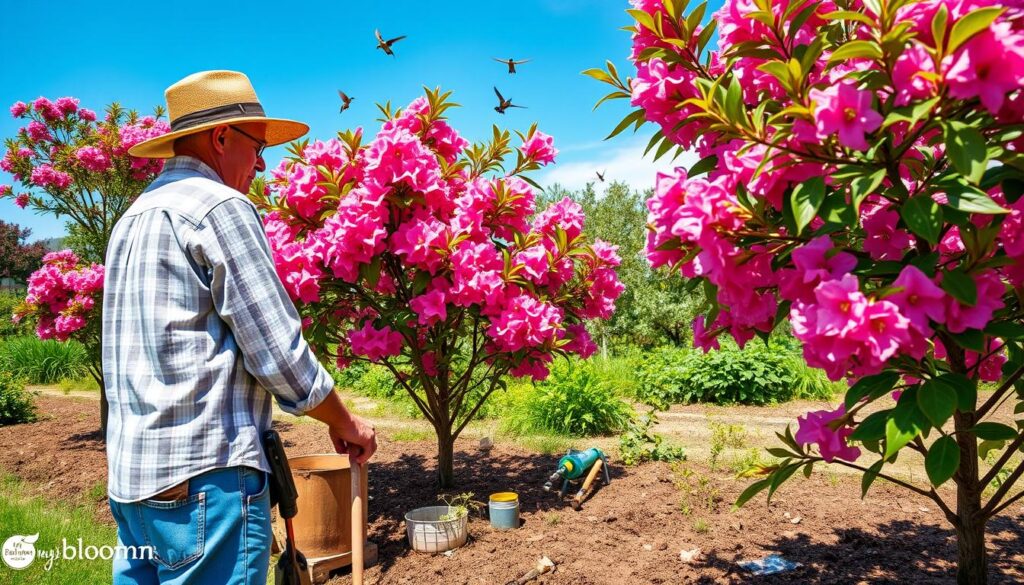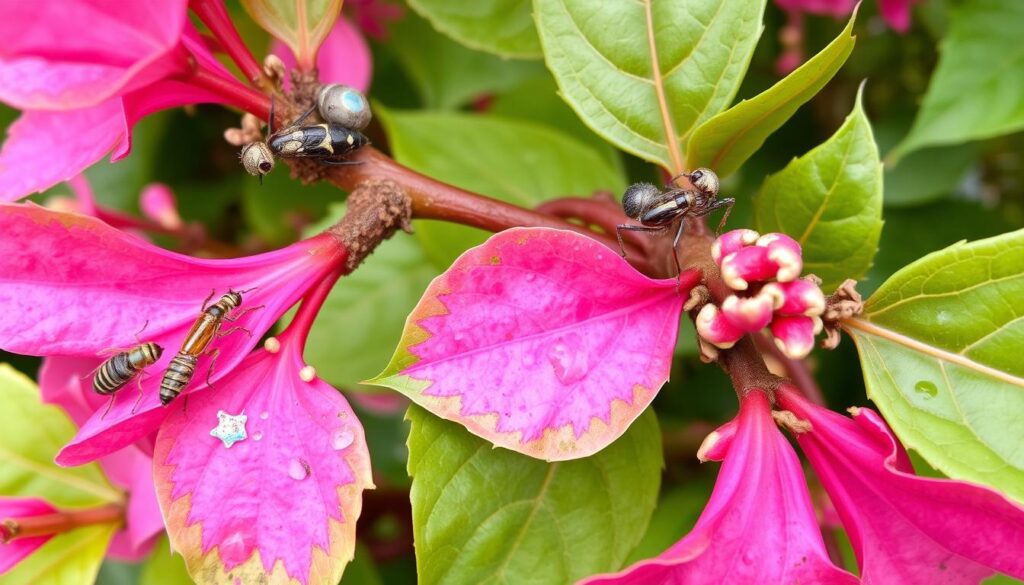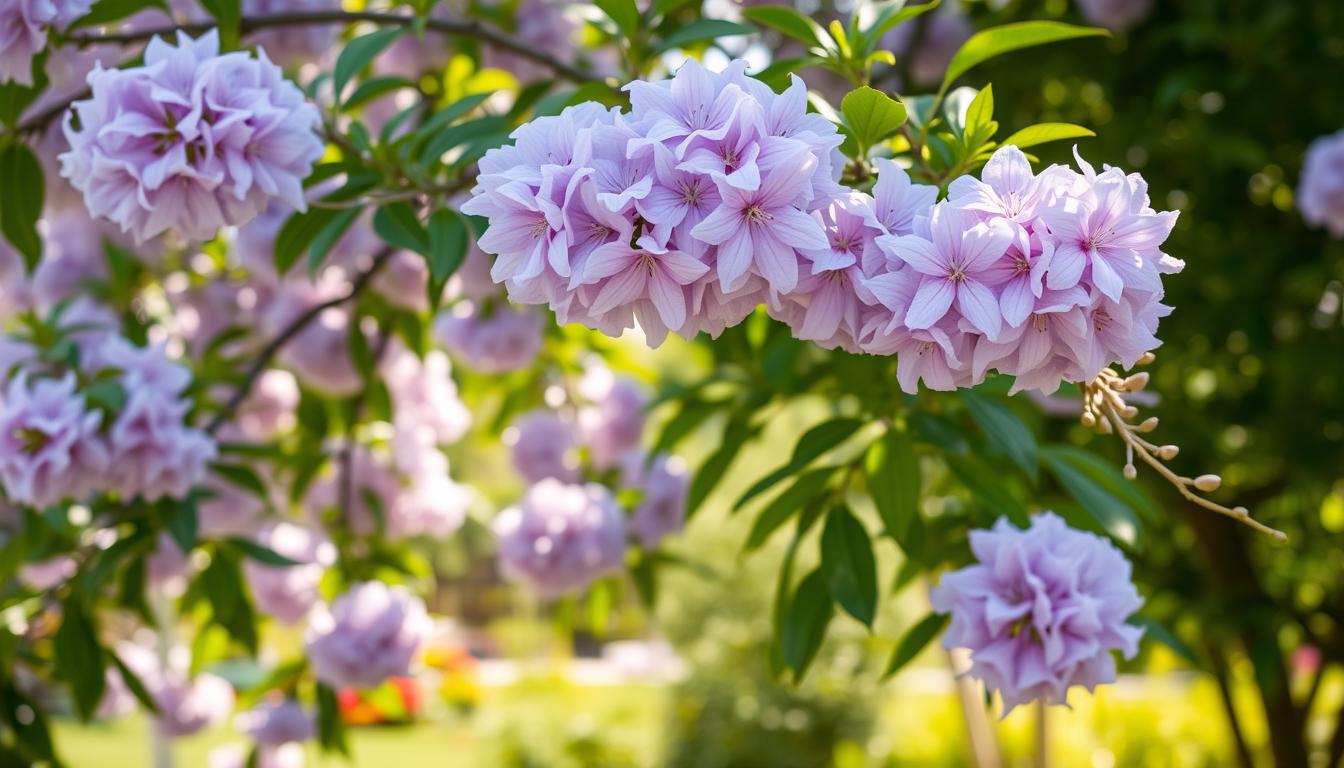The Lagerstroemia Muskogee, or Muskogee crape myrtle, is special to me. It’s a native of the Southern United States. This tree has been in my family’s garden for many years.
Its lavender-pink flowers are stunning. They seem to dance in the summer breeze. This tree is easy to care for and adds beauty to our yards.
Table of Contents
Understanding the Lagerstroemia Muskogee Variety
The Lagerstroemia Muskogee, also known as the Muskogee crape myrtle, is a favorite among gardeners. It comes from a successful breeding program. This variety has unique traits that make it a great choice for outdoor spaces.
Origin and Development
Horticulturists worked hard to create the Muskogee crape myrtle. They crossed different Lagerstroemia species to get a plant with the best features. This includes its beautiful lavender-pink blooms.
Distinctive Characteristics
The Muskogee crape myrtle is known for its stunning flowers. The trees and shrubs have lots of lavender-pink blooms that catch the eye. Even when not in bloom, the bark’s mottled pattern adds interest.
Growth Pattern and Mature Size
The Muskogee crape myrtle grows reliably and reaches a consistent size. It grows 20-30 feet tall and wide. This makes it perfect for many landscape uses, like specimen plants or borders.
“The Muskogee crape myrtle is a true showstopper, with its elegant form and captivating lavender-pink blooms that add a touch of Southern charm to any garden.”
Benefits of Growing Muskogee Crape Myrtle in Your Landscape
Adding the Lagerstroemia Muskogee, or Muskogee Crape Myrtle, to your landscape brings many benefits. These drought-tolerant trees bloom for months, showing off bright flowers. They come in various sizes and colors, making them great for any garden.
The Muskogee Crape Myrtle is easy to care for. It needs little pruning and fights off pests well. This makes it perfect for those with little time to garden. Plus, its beauty lasts all year, from flowers to bark.
These drought-tolerant trees also draw in bees and butterflies. This adds to your garden’s beauty. The Muskogee Crape Myrtle is a great pick for adding color or a focal point to your garden.
“The Muskogee Crape Myrtle is a true showstopper in the landscape, with its vibrant blooms and year-round visual interest.”
Thinking about adding this drought-tolerant tree to your garden? The Muskogee Crape Myrtle’s beauty and easy care make it a top choice for garden lovers.
Ideal Growing Conditions for Healthy Development
To make your Lagerstroemia Muskogee, or Muskogee crape myrtle, grow well, you need the right conditions. Let’s look at what’s important for its growth.
Soil Requirements
Muskogee crape myrtles do best in well-drained, slightly acidic soil. The pH should be between 5.5 and 6.5. They like sandy or loamy soil for better nutrient absorption and root growth.
Adding compost or organic matter to the soil helps. It keeps the soil pH right and improves drainage.
Sunlight and Temperature Needs
Muskogee crape myrtles love the sun, needing at least six hours of direct sunlight daily. They can handle some shade, but full sun makes them bloom more. They grow best in USDA Hardiness Zones 7 to 9.
These zones have warm summers and mild winters. This is perfect for these plants.
Water and Drainage Considerations
Good crape myrtle care means keeping the soil moist but not too wet. Muskogee crape myrtles need regular water, especially when it’s dry. But, they can’t stand waterlogged soil.
So, it’s key to make sure the soil drains well. This keeps your plant healthy and long-lasting.
By giving your Muskogee crape myrtle the best growing conditions, it will thrive. It will become a beautiful centerpiece in your garden.
Seasonal Care and Maintenance Guide
Keeping your crape myrtle beautiful and healthy all year is important. It needs careful pruning and the right food to grow well. The Lagerstroemia Muskogee variety needs your attention to do well in your garden.
In early spring, start by clearing any fallen leaves or debris around the tree. This helps the soil breathe and keeps diseases away. Then, give it a balanced, slow-release fertilizer to feed its roots and help it grow strong.
- Fertilize your crape myrtle in late winter or early spring, just before new growth starts.
- Spread the fertilizer evenly around the tree’s drip line, but not on the trunk.
- Add a layer of organic mulch to keep moisture in and weeds out.
As the seasons change, so should your care for the crape myrtle. In summer, make sure it gets enough water, especially when it’s hot or dry. Prune in late winter to shape the tree and get more flowers.
“Consistent, thoughtful care is the key to maintaining the health and vibrant appearance of your Lagerstroemia Muskogee.”
By following this guide, your crape myrtle will bloom beautifully all year. It will add color and beauty to your outdoor space.

Pruning Techniques for Optimal Growth and Blooming
Proper pruning is key for your Lagerstroemia Muskogee crape myrtle’s health and beauty. By learning the best crape myrtle pruning practices, you can have a vibrant tree. It will show off its stunning flowers every season.
Timing Your Pruning
For the best results, prune your Muskogee crape myrtle in late winter or early spring. Prune before new growth starts. This lets the tree heal and grow strong before the growing season.
Proper Cutting Methods
- Make clean, angled cuts just above an outward-facing bud or branch. This encourages the tree to grow in a balanced and aesthetically pleasing shape.
- Avoid leaving short stubs, as they can lead to disease and decay. Instead, cut the branch or stem back to the next healthy bud or branch junction.
- Use sharp, high-quality pruning tools to ensure clean, precise cuts that heal quickly.
Shape Management
To keep your Lagerstroemia Muskogee looking good, focus on thinning out the interior. Remove any crossing or rubbing branches. This improves air circulation and light, helping with bloom production.
“Proper pruning is the key to unlocking the full potential of your crape myrtle’s stunning blooms and graceful form.”
By using these crape myrtle pruning methods, your Muskogee crape myrtle will be beautiful for years.
Common Pests and Diseases Prevention
As a proud owner of a Lagerstroemia Muskogee, keeping it healthy is key. This beautiful Southern crape myrtle is mostly disease-resistant. But, it can still get pests and diseases if not cared for right. Let’s look at common problems and how to prevent them to keep your Muskogee happy and healthy.
One big worry for crape myrtle lovers is crape myrtle pests. Aphids, for example, can harm the leaves and stems. They can slow growth and make the plant look bad. To fight these pests, use insecticidal soaps or neem oil. They kill aphids without hurting the plant.
Powdery mildew is another problem. It looks like a white, powdery coating on leaves. To avoid it, make sure air moves well around the plant. Prune it to let more light in. If you do get powdery mildew, use a fungicide made for disease resistance in crape myrtles.
Also, watch out for bark scale. It can harm the tree’s bark. Check your tree often and treat it quickly with horticultural oils or insecticidal soaps. This will keep your Muskogee crape myrtle safe and healthy.
“Proactive pest and disease management is the key to ensuring a vibrant and long-lasting Lagerstroemia Muskogee in your landscape.”
By knowing about common crape myrtle problems and taking steps to prevent them, you can keep your Muskogee crape myrtle beautiful and strong for many years.

Propagation Methods for Lagerstroemia Muskogee
Propagating the stunning Lagerstroemia Muskogee, or Muskogee crape myrtle, is a rewarding journey for gardeners and plant enthusiasts. Whether you prefer the ease of crape myrtle propagation through cuttings or the excitement of growing from cuttings and seed propagation, this versatile tree offers multiple avenues for multiplication.
Cutting Propagation
One of the most popular methods for propagating Muskogee crape myrtles is through cuttings. Take softwood or semi-hardwood cuttings in the late spring or early summer, selecting healthy, non-flowering shoots. Prepare the cuttings by removing the lower leaves and dipping the base in a rooting hormone to encourage root development.
Plant the cuttings in a well-draining medium, such as a mix of perlite and peat moss. Keep them consistently moist until rooting occurs, which can take 4-8 weeks.
Seed Collection and Growing
For those interested in seed propagation, collect the seed pods from your Muskogee crape myrtle in the fall when they turn brown and split open. The small, winged seeds can be extracted and sown directly in seed trays or containers filled with a well-draining, seed-starting mix. Cover the seeds lightly with soil and keep the medium consistently moist until germination, which can take 2-4 weeks.
Once the seedlings have developed their first set of true leaves, transplant them into larger containers or directly into the garden.
“Propagating your own Muskogee crape myrtles is a rewarding and cost-effective way to expand your landscape and share these beautiful trees with friends and neighbors.”
Whether you choose growing from cuttings or seed propagation, the Lagerstroemia Muskogee is a resilient and adaptable species that can thrive with proper care and attention. Experiment with both methods to discover the one that works best for your gardening preferences and climate.
Landscaping Ideas and Design Tips
The Lagerstroemia Muskogee, or Muskogee crape myrtle, is a versatile and eye-catching tree. It can add elegance to your outdoor spaces. This southern tree offers many possibilities.
As a specimen tree, the Muskogee crape myrtle stands out. Its striking form and vibrant blooms draw the eye. It’s perfect for creating drama. You can also plant them in groupings for a lush look.
In a mixed border, the Muskogee crape myrtle adds beauty. Its silhouette and flowers complement other plants. It also fits well in informal garden styles, adding southern charm.
“The Lagerstroemia Muskogee is a true showstopper in any landscape, with its stunning flowers and elegant form.”
Think about the Muskogee crape myrtle’s mature size when placing it. Leave enough space for it to grow. This ensures it can develop its full structure and canopy.
Adding the Lagerstroemia Muskogee to your landscape makes it stunning. It creates a harmonious outdoor space that showcases this remarkable tree’s beauty.
Winter Protection and Cold Hardiness
As winter gets closer, it’s important to think about your Lagerstroemia Muskogee’s needs. This beautiful tree is adaptable, but harsh winters need extra care. It’s key to keep it safe and thriving.
The cold hardiness of the Lagerstroemia Muskogee is a big factor. It can handle temperatures down to 0°F (-18°C). But in very cold areas, more frost protection might be needed.
- Mulching the base with 2-4 inches of organic material helps protect the roots from frost.
- Wrapping the trunk and branches with burlap or a tree wrap adds extra cold tolerance.
- In extreme cold, covering the tree with a breathable fabric or frost blanket is a good idea.
By using these winter care tips, your Lagerstroemia Muskogee will do well all year. With the right frost protection, you’ll enjoy its beautiful blooms and foliage for years.
“Proper winter protection is key to the long-term success of Lagerstroemia Muskogee in northern regions.”
Companion Plants and Garden Integration
Boosting your Lagerstroemia Muskogee crape myrtle’s look and health is easy with the right plants. Choose plants that match well with your Muskogee to make a beautiful garden. This will highlight the Muskogee’s stunning beauty.
Best Plant Combinations
When picking plants to go with your Muskogee, think about their colors, textures, and when they bloom. This will make your garden look amazing. Here are some great choices:
- Agapanthus: Its big, round flowers in blue or white look great next to the Muskogee’s pink blooms.
- Coneflowers (Echinacea): Their bright, daisy-like flowers in pink, purple, or white match the Muskogee’s soft colors.
- Ornamental Grasses: Grasses like Pennisetum or Miscanthus add a cool contrast with their flowing movement.
Spacing Guidelines
When adding a Muskogee to your garden, think about how far apart to plant them. Aim for 15-20 feet between Muskogees and big trees or shrubs. This lets each plant grow well without getting too crowded.
For smaller plants, like perennials or annuals, plant them 12-18 inches apart. This makes your garden look good and helps plants get the air and nutrients they need.
“The secret to a beautiful, thriving garden is in the harmonious integration of the right plants, each complementing the other.”
Conclusion
The Lagerstroemia Muskogee is a stunning crape myrtle variety. It’s perfect for landscape design because of its elegant look and easy care. It’s great for both homeowners and gardeners.
We’ve talked about the Muskogee crape myrtle’s origins and how to grow it. It does well in many climates and soil types. Its beautiful blooms and autumn colors make it a standout in your garden.
Thinking about your landscape? The Lagerstroemia Muskogee is a great choice. It can be a focal point, part of a mixed border, or a natural privacy screen. This crape myrtle will surely impress everyone. Let it become a special part of your dream garden.

